New products at Crocus
by Sarah - July 15th, 2010.Filed under: Crocus, New Products.
New lines at Crocus
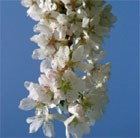
ornamental cherry £44.99
Position: full sunSoil: tolerates most soilsRate of growth: average, can prune hard.Flowering period: March/AprilFlower colour: whiteOther features: good autumn leaf coloursHardiness: fully hardyA beautiful weeping tree that is ideal for the smallest gardens and will thrive in large tubs. Its long, weeping branches are smothered in pure white flowers in March and April and create a cascade effect. The flowers are produced on the current year’s growth, so the branches can be pruned hard each year after flowering if required. The leaves are small, mid-green, and turn lush shades of burgundy and red in autumn.Garden care: When planting, incorporate lots of well-rotted compost in the planting hole and stake firmly. If potting up use John Innes No3 compost and make sure it is kept well watered during warm weather. Any necessary pruning should be done in summer to reduce the risk of bacterial canker canker.

scotch laburnum £42.99
Position: full sunSoil: well-drained soilRate of growth: fast-growingFlowering period: May to JuneHardiness: very hardy A small, spreading tree with weeping branches that is perfect for smaller gardens. In late spring and early summer slender racemes of brilliant, golden-yellow flowers seem to drip from the branches creating a luminous display. An excellent specimen plant, that is best appreciated when not overcrowded. Garden care: When planting, incoporate lots of well-rotted manure or garden compost into the planting hole and stake firmly. Laburnums dont need much pruning, but you may want to remove any diseased or crossing branches. It is essential that any pruning work is carried out between late summer to mid winter as the sap will ‘bleed’ heavily at other times.

maidenhair tree £34.99
Position: sunSoil: fertile, well-drained soilRate of growth: slow-growingFlowering period: April to MayHardiness: fully hardyThis wonderful, ancient tree from China dates back at least 200 million years. Its distinctive, fan-shaped, bright green leaves turn bright gold when a warm autumn follows a warm summer. Mature male trees have thick, yellow catkins in late spring. This tree usually starts life shaped like a flagpole but gradually becomes wide spreading. It can cope with many city conditions, including pollution, and makes an elegant tree for a larger garden. Maidenhair trees were introduced to Japan about 1,000 years ago and often grown near temples – one reason why they are a common feature in Japanese-style gardens. The first maidenhair tree was brought to Britain and planted in Kew Gardens in 1760. It still stands today. Garden care: Requires minimal pruning. Remove any broken, diseased or crossing branches in late autumn or winter. When planting incorporate lots of well-rotted garden compost in the planting hole and stake firmly.
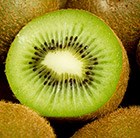
kiwi fruit £32.99
Position: full sunSoil: fertile, well-drained soilRate of growth: fast-growingFlowering period: JuneFlower colour: creamy-whiteOther features: delicious, greenish-brown kiwi fruitHardiness: frost hardy (may need winter protection) This is a self-fertile variety that produces both male and female creamy-white flowers, so it does not need a pollinating partner to produce delicious, greenish-brown kiwi fruit – perfect if there is only enough space for one fruiting plant. It is a vigorous, deciduous climber, which is best suited for training as an espalier against a warm, sheltered wall in a sunny spot, where it will start producing fruit around 3 years after planting.Garden care: Provide good support with a network of horizontal galvanised wires spaced at 30cm intervals and using raffia or garden twine tie in the plant, first vertically up a bamboo cane and then laterally, along the wires as it grows. It produces fruit on one year old wood, so you should aim to train pairs of lateral stems to develop permanent fruiting stems. When these exceed the alloted space, pinch out the tips and train a new leading shoot. It may take 3 or 4 years to start to producing fruits.
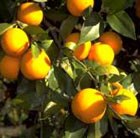
Sweet Orange £22.49
A large, rounded shrub or small tree with dark green leaves. In spring, fragrant white flowers are produced, followed by round, sweet oranges in winter. It is an ideal plant for growing in a pot on the patio, but will need to be moved to a frost-free place in winter in cooler regions.Position: full sunSoil: moist but well-drained, slightly acidic soilRate of growth: averageFlowering period: April to JulyFlower colour: fragrant whiteOther features: sweet oranges (December)Hardiness: tender to frost hardyGarden care: In pots grow in John Innes No2 potting compost in full sun. Feed every two weeks in the growing season with a balanced plant food. Pot on or top-dress plants in late winter. Outdoors grow in slightly acidic, well-drained soil in full sun. Minimal pruning is requiredGoes well with: Ficus carica, Myrtus communis, Yucca Flaccida ‘Ivory’, Agave americana ‘variegata’, Foeniculum vulgare ‘Purpureum’, Aloysia triphylla

orange – mini £19.99
Position: full sunSoil: moist but well-drained, slightly acidic soilRate of growth: averageFlowering period: April to JulyHardiness: tender to frost hardy (will need protection in winter)Fabulous, fragrant white flowers are produced singly on branches throughout the summer.These are followed by medium-sized, thin-skinned, juicy tangerines that separate easily into segments. A great plant for growing in a pot on a sunny patio, but it will need to be moved in to a frost-free place in winter.Garden care: In pots grow in John Innes No2 potting compost in full sun. Feed every two weeks in the growing season with a balanced plant food. Pot on or top-dress plants in late winter. Outdoors grow in slightly acidic, well-drained soil in full sun. Minimal pruning is required.
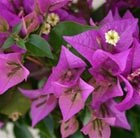
Bougainvillea £14.99
Position: full sunSoil: loam-based potting compostRate of growth: average Flowering period: July to SeptemberHardiness: tenderA common sight in Mediterranean countries, bougainvillea produces magnificent clouds of magenta floral bracts from July to September. It grows quickly and is evergreen, and can be grown outside on a sunny patio, provided it is brought indoors in autumn. Alternatively, it makes an ideal conservatory plant.Bougainvilleas can be long-lived and last for over 50 years if given the correct care. They much prefer a heated conservatory and tend to go dormant at around 10C, when they lose their leaves and flowers. Temperatures below this can be fatal. Once dormant, keep on the dry side until they come back into growth. When they are growing well feed weekly with a balanced liquid fertiliser and lightly prune to keep the plant bushy.Garden care: Water moderately during the growing season, applying a balanced liquid fertiliser each month. Water sparingly during winter and re-pot or top-dress in spring.

Japanese wineberry £12.99
Position: full sunSoil: fertile, well-drained soilRate of growth: fast-growingOther features: softly hairy, bare stems look good in winterHardiness: fully hardyStill quite rare here in the UK, but hopefully that will all change quite soon. These incredibly sweet, orange red to dark red berries are delicious if picked and eaten straight from the bush when they ripen in August, or can be cooked up in the same way as you would raspberries (which they are closely related to). They come on a large, deciduous bush that is easy to grow, although you will get the best fruit when it is trained against a sunny, south-facing wall or fence.Garden care: Prepare the planting area well, removing all perennial weeds and adding plenty of well-rotted garden compost or manure. Plant canes 45cm (18in) apart in a trench 8cm (3in) deep, carefully spreading out the roots and backfilling with soil.
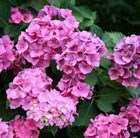
mophead hydrangea £8.99
Position: full sun or partial shadeSoil: moist, well-drained, moderately fertile, humus-rich soilRate of growth: average Flowering period: July and August Flower colour: rich pink (dark purple-blue on acid soils)Other features: contact with the foliage may aggravate skin allergies; the flower-heads make excellent dried flower arrangementsHardiness: fully hardyLarge heads of rich-pink to dark purple-blue flowers from July to August and coarsely toothed, dark green leaves. This compact, hortensia hydrangea is perfect for where border space is limited. Best in partial shade, on neutral soils a ‘blueing compound’ may be applied every 7-14 days to produce blue flowers.Garden care:To enhance flowering prune in spring, cutting back the flowered stems to a strong pair of buds below each flower-head. Once established, remove a quarter to a third of the old shoots to the base of the plant






